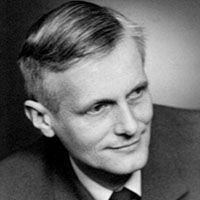
You have no items in your cart

SUMMER SALE
20% discount on all orders until August 31, 2024

Samuel Ducommun composer from Neuchâtel, Switzerland, studied organ with Louis Kelterborn and Charles Faller, and received his Virtuosity Prize in 1938. Student of Charles Humbert in music theory he continued his studies with Paul Benner in counterpoint and composition. He later became a pupil of Marcel Dupré. His career as an organist began in 1934 in Corcelles, Switzerland; from 1938-1942 he held the same position at the Stadtkirche in Biel. After 1942 he was appointed organist at the Collégiale Church of Neuchâtel, a city who becam the center for his many musical activities.
As a performer, Samuel Ducommun Having composed since adolescence, he produced a considerable body of work featuring of course the organ, but also several sacred and secular cantatas, symphonic or concertante works, and much chamber music of very diverse instrumentations round out the catalog of his compositions.
Samuel Ducommun developed his own musical style, which neither imitated anyone nor renounced his origins. The style and spirit of his compositions is inspired by French music. If his structures often come from the classical (fugue, passacaglia, sonata), his expression is generally polytonal, sometimes modal, even atonal. His polyphonic writing avoided uniformity, knowing how to follow stricktly the rules of counterpoint, but also giving the illusion of free improvisation, an art in which Samuel Ducommun excelled.
Never academic in his writing, the composer always put form at the service of inspiration and expression. His themes, melodically as well as rhythmically are rich and distinctive. His lines are clear and his palette is infinitely colored, especially in registration and orchestration. The material may be traditional, but the works are original. A man animated by a profound spirituality, as evidenced in his musical production, be it religious, secular or purely instrumental, Samuel Ducommun was a humanist in the broadest sense of the term.played in many cities in Switzerland, France and Germany.